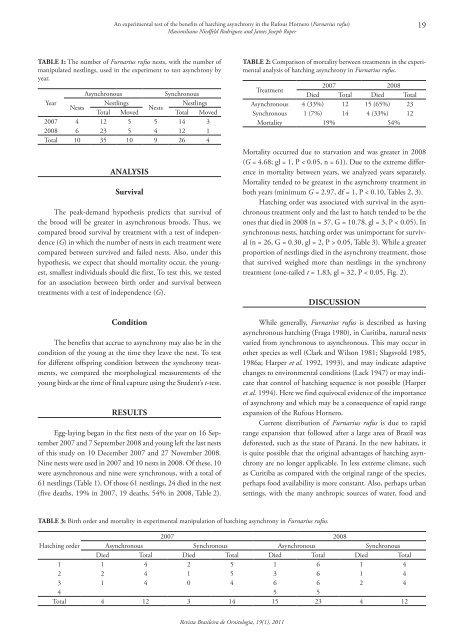Capa 19(1) - fechada.indd - Sociedade Brasileira de Ornitologia
Capa 19(1) - fechada.indd - Sociedade Brasileira de Ornitologia
Capa 19(1) - fechada.indd - Sociedade Brasileira de Ornitologia
You also want an ePaper? Increase the reach of your titles
YUMPU automatically turns print PDFs into web optimized ePapers that Google loves.
An experimental test of the benefits of hatching asynchrony in the Rufous Hornero (Furnarius rufus)<br />
Maximiliano Niedfeld Rodriguez and James Joseph Roper<br />
<strong>19</strong><br />
Table 1: The number of Furnarius rufus nests, with the number of<br />
manipulated nestlings, used in the experiment to test asynchrony by<br />
year.<br />
Asynchronous<br />
Synchronous<br />
Year<br />
Nestlings<br />
Nestlings<br />
Nests<br />
Nests<br />
Total Moved Total Moved<br />
2007 4 12 5 5 14 3<br />
2008 6 23 5 4 12 1<br />
Total 10 35 10 9 26 4<br />
Analysis<br />
Survival<br />
The peak-<strong>de</strong>mand hypothesis predicts that survival of<br />
the brood will be greater in asynchronous broods. Thus, we<br />
compared brood survival by treatment with a test of in<strong>de</strong>pen<strong>de</strong>nce<br />
(G) in which the number of nests in each treatment were<br />
compared between survived and failed nests. Also, un<strong>de</strong>r this<br />
hypothesis, we expect that should mortality occur, the youngest,<br />
smallest individuals should die first. To test this, we tested<br />
for an association between birth or<strong>de</strong>r and survival between<br />
treatments with a test of in<strong>de</strong>pen<strong>de</strong>nce (G).<br />
Condition<br />
The benefits that accrue to asynchrony may also be in the<br />
condition of the young at the time they leave the nest. To test<br />
for different offspring condition between the synchrony treatments,<br />
we compared the morphological measurements of the<br />
young birds at the time of final capture using the Stu<strong>de</strong>nt’s t‐test.<br />
Results<br />
Egg-laying began in the first nests of the year on 16 September<br />
2007 and 7 September 2008 and young left the last nests<br />
of this study on 10 December 2007 and 27 November 2008.<br />
Nine nests were used in 2007 and 10 nests in 2008. Of these, 10<br />
were asynchronous and nine were synchronous, with a total of<br />
61 nestlings (Table 1). Of those 61 nestlings, 24 died in the nest<br />
(five <strong>de</strong>aths, <strong>19</strong>% in 2007, <strong>19</strong> <strong>de</strong>aths, 54% in 2008, Table 2).<br />
Table 2: Comparison of mortality between treatments in the experimental<br />
analysis of hatching asynchrony in Furnarius rufus.<br />
Treatment<br />
2007 2008<br />
Died Total Died Total<br />
Asynchronous 4 (33%) 12 15 (65%) 23<br />
Synchronous 1 (7%) 14 4 (33%) 12<br />
Mortality <strong>19</strong>% 54%<br />
Mortality occurred due to starvation and was greater in 2008<br />
(G = 4.68; gl = 1, P < 0.05, n = 61). Due to the extreme difference<br />
in mortality between years, we analyzed years separately.<br />
Mortality ten<strong>de</strong>d to be greatest in the asynchrony treatment in<br />
both years (minimum G = 2.97, df = 1, P < 0.10, Tables 2, 3).<br />
Hatching or<strong>de</strong>r was associated with survival in the asynchronous<br />
treatment only and the last to hatch ten<strong>de</strong>d to be the<br />
ones that died in 2008 (n = 37, G = 10.78, gl = 3, P < 0.05). In<br />
synchronous nests, hatching or<strong>de</strong>r was unimportant for survival<br />
(n = 26, G = 0.30, gl = 2, P > 0.05, Table 3). While a greater<br />
proportion of nestlings died in the asynchrony treatment, those<br />
that survived weighed more than nestlings in the synchrony<br />
treatment (one-tailed t = 1.83, gl = 32, P < 0.05, Fig. 2).<br />
Discussion<br />
While generally, Furnarius rufus is <strong>de</strong>scribed as having<br />
asynchronous hatching (Fraga <strong>19</strong>80), in Curitiba, natural nests<br />
varied from synchronous to asynchronous. This may occur in<br />
other species as well (Clark and Wilson <strong>19</strong>81; Slagsvold <strong>19</strong>85,<br />
<strong>19</strong>86a; Harper et al. <strong>19</strong>92, <strong>19</strong>93), and may indicate adaptive<br />
changes to environmental conditions (Lack <strong>19</strong>47) or may indicate<br />
that control of hatching sequence is not possible (Harper<br />
et al. <strong>19</strong>94). Here we find equivocal evi<strong>de</strong>nce of the importance<br />
of asynchrony and which may be a consequence of rapid range<br />
expansion of the Rufous Hornero.<br />
Current distribution of Furnarius rufus is due to rapid<br />
range expansion that followed after a large area of Brazil was<br />
<strong>de</strong>forested, such as the state of Paraná. In the new habitats, it<br />
is quite possible that the original advantages of hatching asynchrony<br />
are no longer applicable. In less extreme climate, such<br />
as Curitiba as compared with the original range of the species,<br />
perhaps food availability is more constant. Also, perhaps urban<br />
settings, with the many anthropic sources of water, food and<br />
Table 3: Birth or<strong>de</strong>r and mortality in experimental manipulation of hatching asynchrony in Furnarius rufus.<br />
2007 2008<br />
Hatching or<strong>de</strong>r Asynchronous Synchronous Asynchronous Synchronous<br />
Died Total Died Total Died Total Died Total<br />
1 1 4 2 5 1 6 1 4<br />
2 2 4 1 5 3 6 1 4<br />
3 1 4 0 4 6 6 2 4<br />
4 5 5<br />
Total 4 12 3 14 15 23 4 12<br />
Revista <strong>Brasileira</strong> <strong>de</strong> <strong>Ornitologia</strong>, <strong>19</strong>(1), 2011

















